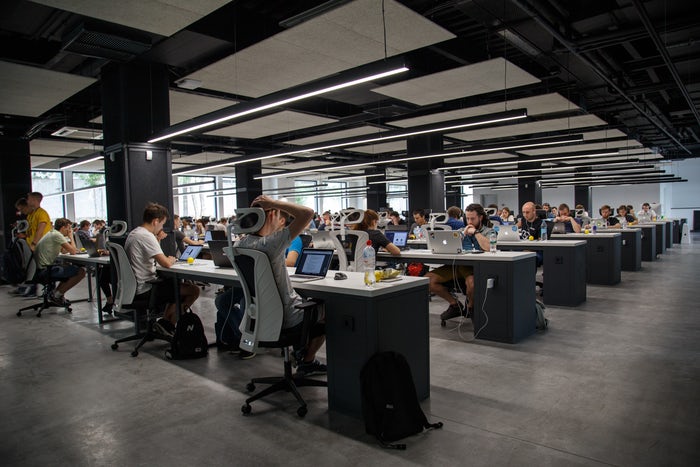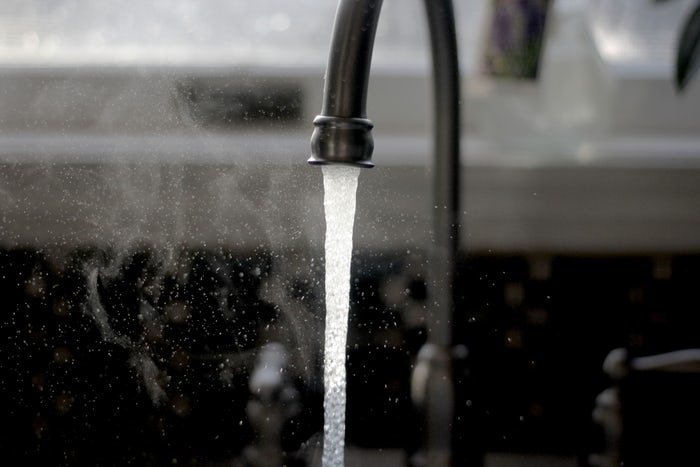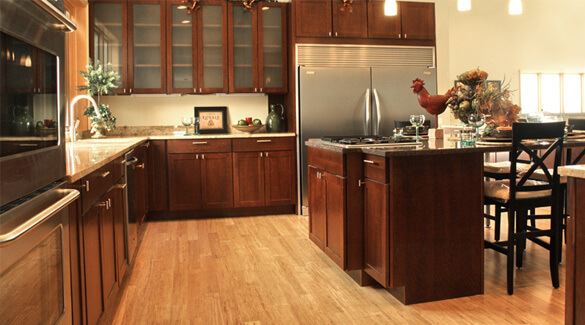As society becomes more aware of sustainability and the eco-threats facing our little blue planet, we naturally want to do all we can to protect it. That’s why we use canvas shopping bags, use public transport more frequently, and even go on litter picks in our local neighborhood.
It’s great that everyone is trying to do their part to live greener lives at home, but one important area of our lives that could do with some major sustainability improvements is our workplaces. The average American in full-time employment spends 47 hours a week at work (Geez!), so wouldn’t it be great if we could make it a little greener?
There are a lot of benefits available for businesses that adopt sustainable practices, including:
- improved brand image (which attracts employees and investors)
- reduced waste
- reduced costs
- improved productivity.
So whether you’re the owner, the manager, or even if you’ve just started as an office junior, it’s worth looking into some of the ways to create an eco-friendly workplace.
How to create a greener workplace
Here we’ll go through some of the ways that you can help your company become more sustainable, including some that barely takes any effort at all.
1. Host a meeting about sustainability
While most people will understand why going green in the office is important, there will always be some people who just don’t care. They’ll throw their plastic bottle into the bin, forget to turn lights off when they leave a room, and even run the water for a crazy long time in the kitchen.
Are you washing your mug or running a bath? I swear that tap’s been on for ten minutes.
That’s why it’s important to explain to everyone at a meeting why your workplace is going green and what everyone’s responsibilities are. It may even be worth appointing some of the more eco-minded employees as ‘green heroes’ to keep a check on how sustainability is being implemented.
Cutting waste
2. Set up a recycling scheme
All commercial spaces have to employ a waste contractor to remove their garbage. If your place of business is inside a shopping center or office block, this might be organized centrally by the building manager.
The good thing is that these waste contractors will also be able to remove your recycling for you. Ask your waste contractor about their recycling scheme, including how much it costs, what can be recycled, and what happens to it after it’s collected.
To sort these items properly, you may need to set up a clearly labeled recycling bin. Bonus, this also acts as a visual prompt for the less-eco employees to recycle as well.
3. Set up a compost scheme
Depending on your type of business, you may find that you have compostable materials (i.e. fruit and veg, coffee grounds). If there’s not too much, you can distribute it among the keen gardeners in your staff.
If there’s a lot, however, consider donating it to the local allotment or community garden. Not only will it enrich the soil and be kinder to the earth, but it can also get the name of your business out to the public and earn you some green credibility.
4. Switch to LED light bulbs
You can now upgrade to LED light bulbs for both the fluorescent strip lighting that is commonly used in workplaces and the more traditional bulb lighting. Not only will this be better for the planet, but it also saves you money in the long run as the bulbs need replacing much less often.
5. Install motion sensors for lighting
Even with LED light bulbs, it still doesn’t make sense to leave the lights on in unoccupied rooms. However, the nature of being human means we often forgot to switch the lights off and, as a result, the bathroom, kitchen, or conference room can be lit for hours without a soul in there.
Switching to motion sensor lights will mean that the lights come on when you enter a room and turn off if they don’t detect movement for a while.
For those worried about the lights going off in the middle of a meeting with a client and having to wave their arms about like a fool to get the lights to come back on, don’t panic.
- Your client will probably be impressed with your sustainability practices
- Most motion sensors have an override switch that will last for a couple of hours while you hold a meeting
6. Use smart power strips
When it gets to the end of the day, most employees will be keen to get out of the door. This isn’t a slight on your workplace. Even those who love their jobs, generally have family that they want to get home to or friends to meet up with.
This rush to leave work can sometimes mean that employees forget to switch off all of the equipment that they’ve used and leave devices on all night. Whoops! Luckily, smart power strips can turn off all connected devices when the computer is turned off, so you can save energy with less effort.
7. Use only recycled/post-consumer waste paper
Every business uses paper at some stage. Even if you’re not printing off *insert business jargon here* reports from the past quarter, you’ll be giving receipts or invoices to customers or even just using notepads to write down your ideas.
Using recycled paper will go a long way to reducing your eco-impact.
8. Print on both sides of the paper
While we’re on the topic of saving the trees, it’s worth noting that most computers/printers can be set up to print on both sides of the paper by default. If you do need to print something on single-sided paper (i.e. a contract), then you can override the default settings manually for the individual printing job.
9. Install low-flow toilets
At home, some eco people may choose not to flush the toilet unless it’s a number two, as this saves tons of water. However, at work, this is not a great idea, especially if those toilets are used by the public.
Actually, it’s pretty grim even if the staff are the only people to use them. Please flush, guys!
Instead, why not install low flow toilets when updating your bathrooms? If you aren’t updating the bathrooms for ages yet, you can eco hack your existing toilets using a plastic bottle. Easy, right?
10. Use cloths instead of paper towels
By drying your hands with towels rather than paper, you’ll save a lot of trees. If you’re worried about germs, you can always put a separate towel for each person that is washed at the end of the week or wash one towel every day.
11. Install low flow faucet aerators on sinks
Unlike your toilets, this doesn’t require a whole new sink and the aerators are pretty easy to install yourself. They reduce the water flow from taps, meaning that less water is wasted whether you’re washing your hands or filling the kettle.
12. Ditch disposables
If your workplace is still using disposable napkins, crockery, cutlery, consider replacing them with reusable items. It’ll cost a little more initially but will likely pay for itself in the first year.
If your business offers takeaway food or drinks, then consider these options:
- offering a discount for customers who bring their own containers (i.e. reusable mugs)
- using only recyclable packaging
- operating a deposit scheme where customers return reusable containers in exchange for money off
13. Encourage employees to cut their car commute
If you really want to reduce your business’ carbon footprint, consider helping employees to reduce their car usage to and from work. There are several ways that you can do this, including:
- Installing a bike rack, so that your employees have somewhere safe to leave their bikes
- Providing loans for employees to buy bikes or annual passes for public transport, as this is often a huge hit from one single pay packet
- Allowing employees to work from home where necessary, which will cut car usage and also allow employees more flexibility in their working lives
- Starting up a car share scheme, which will allow employees that live near each other to bond on the way to work and cut petrol usage
Other eco changes
14. Add more plants
Most people are aware that plants are incredible for removing pollutants, like carbon dioxide, from the atmosphere and pumping out oxygen in return. What many people don’t know is that indoor air pollution can actually be worse than outside air pollution in some instances. Yikes!
A nice rubber plant in the corners of the office or a potted cactus near the cash register will brighten the workplace, help remove pollutants, and can even improve employee happiness.
15. Install a bamboo floor
The floor will likely be one of your top concerns when fitting out your workplace. You’ll want something that is
- attractive enough to appeal to customers
- durable enough to handle the foot traffic
- long-lasting enough that you won’t need to replace it in a few short years
A bamboo floor will do all of that and more. Let’s learn more.
Attractive
Source: Ambient BambooBamboo floors are beautiful to look at and can be easily customized to the look and feel of your workplace with a multitude of design options.
If you own an artisanal coffee house, you might prefer a more textured plank with a carbonized finish. If you’re looking to refit a Silicon Valley-Esque tech company, then you might prefer a lighter, smoother plank. If you own a health food store, you might prefer the light and airy tone of natural bamboo flooring, like that featured in the above photo, to fit in with an organic, aesthetic atmosphere.
Whatever look you’re going for, bamboo flooring can fit into it.
Durable
Strand woven bamboo is the toughest material for flooring, beating out all hardwoods in the Janka Hardness scale. It can handle decades’ worth of foot traffic, support heavy furniture, and even resist scratches from those people who just scrape their chairs backward on the floor when getting up from their desks.
Side note: If you’re one of the chair scrapers, this is not a ‘get out of jail free’ card. The noise is still super annoying and distracts other people who are right in the middle of something, Brad!
One of the other benefits of bamboo flooring is that it can withstand water damage from minor spills without any damage to the boards. I know I’m not the only person who’s knocked their morning cup of coffee on the floor when trying to find the right file for the boss. Mornings are hard, okay?
Long-lasting
Bamboo floors first started to be installed commercially in the 90s, and the majority of those floors are still in use today. Why? Because bamboo is so durable that it lasts for a long time without needing repairs or replacements.
Even in high traffic commercial spaces, like coffee shops and corner stores, bamboo floors are more resilient to scratches, scuffs, and dents, than many other flooring types, like hardwoods, linoleum, and tiles.
This all means that your bamboo floor can last for years or even decades before it even needs refinishing, let alone replacing. This is especially awesome for businesses because it means that you need to shut for less time to carry out repairs, which means more time making money.
Different types of bamboo flooring
In a separate blog post, I’ve spoken in-depth about the different types of bamboo flooring, what the differences are, and why that’s important for you to know.
Here I’d like to advise that for commercial spaces, which are a lot busier than residential settings, you need to use strand woven bamboo floors (i.e. the hardest flooring type in the world!) or engineered bamboo flooring (this offers additional dimensional stability and is great for use under heavy furniture).
Solid bamboo flooring (also known as traditional bamboo flooring) is perfectly strong and stable in your homes but could face problems in a busy shop or office.
16. Support local vendors
No business is an island. I’m pretty sure that’s how the saying goes. What I mean is that every business has to purchase things from other businesses at some point.
Whether it’s business cards for your employees, products to sell in your store, or furniture for your office, try to get them from local vendors where you can. Not only will this stimulate the local economy, but it will also mean less shipping. This is great because shipping can produce a huge amount of packaging waste and a high carbon footprint.
There are my top tips for making your workplace more green, but now I’d like to hear from you. Have you instituted any of these tips? How did they work out?
I’m especially interested in any other eco-hacks that you might have for the workplace, so let me know in the comments below.







